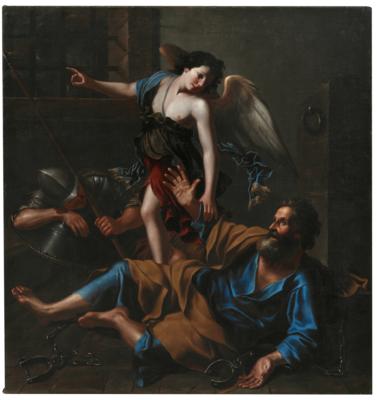Caravaggesque Master, circa 1640

The Liberation of Saint Peter,
oil on canvas, 164.5 x 156.5 cm, framed
According to the Acts of the Apostles (12, 5-12), during the persecution of the first Christian community founded by Erode Agrippa, Saint Peter was thrown into a dungeon to face the judgement of the Eurasian people. However, during the night an angel appeared freeing Peter from his chains and lead him from capture.
The present composition was produced by an artist, long known by art historians as Tommaso Salini. However, an attempt to identify the different hands previously associated with Salini was made by Franco Paliaga (see F. Paliaga, Sui dipinti di genere con animali vivi attribuiti a Tommaso Salini, in: P. Carofano, Atti delle Giornate di Studi sul Caravaggismo e il Naturalismo nella Toscana del Seicento, Pontedera 2009, pp. 117-144). His studies focused on works similar to the present composition, which he described as by the ‘Pseudo Salini’.
In a 2011 article in which he attempted to further distinguish the different artistic personalities concealed in this group, Gianni Papi focused specifically on various figurative paintings, all of which can be attributed to a particular master, whom he identified as the ‘Master of Baranello’ on the basis of comparisons with an Ecce Homo preserved in the Museo di Baranello. On the same occasion, he reordered the group of works attributed to Salini and assigned some to the Maestro dell’ Elemosina di Santa Lucia (who is stylistically very close to Azzolino and therefore probably a Neapolitan). Subsequently, the Salini group was further divided and the ‘Maestro della Flagellazione Lampronti’ was created in a study published by Papi in 2016 (see G. Papi, Il Maestro della Flagellazione Lampronti, in: Entro l’aria bruna d’una camera rinchiusa. Scritti su Caravaggio e l’ambiente caravaggesco, Naples 2016,
pp. 211–227).
In his 2011 article, Papi also briefly mentioned a series of paintings depicting peasants and shepherds with animals that had been discussed by Paliaga two years earlier. Since it was believed that there seemed to be more than one hand within the ‘Pseudo-Salini’ group, the epithet ‘Maestro degli Armenti’ was introduced, with specific reference to a painting depicting a shepherd with sheep and goats published by Viktoria Markova as a work by Salini (see V. Markova, Alcune nuove proposte per Tommaso Salini, in: Paragone, 475, 1989, pp. 26–41).
Esperto: Mark MacDonnell
 Mark MacDonnell
Mark MacDonnell
+43 1 515 60 403
old.masters@dorotheum.com
09.11.2022 - 17:00
- Stima:
-
EUR 40.000,- a EUR 60.000,-
Caravaggesque Master, circa 1640
The Liberation of Saint Peter,
oil on canvas, 164.5 x 156.5 cm, framed
According to the Acts of the Apostles (12, 5-12), during the persecution of the first Christian community founded by Erode Agrippa, Saint Peter was thrown into a dungeon to face the judgement of the Eurasian people. However, during the night an angel appeared freeing Peter from his chains and lead him from capture.
The present composition was produced by an artist, long known by art historians as Tommaso Salini. However, an attempt to identify the different hands previously associated with Salini was made by Franco Paliaga (see F. Paliaga, Sui dipinti di genere con animali vivi attribuiti a Tommaso Salini, in: P. Carofano, Atti delle Giornate di Studi sul Caravaggismo e il Naturalismo nella Toscana del Seicento, Pontedera 2009, pp. 117-144). His studies focused on works similar to the present composition, which he described as by the ‘Pseudo Salini’.
In a 2011 article in which he attempted to further distinguish the different artistic personalities concealed in this group, Gianni Papi focused specifically on various figurative paintings, all of which can be attributed to a particular master, whom he identified as the ‘Master of Baranello’ on the basis of comparisons with an Ecce Homo preserved in the Museo di Baranello. On the same occasion, he reordered the group of works attributed to Salini and assigned some to the Maestro dell’ Elemosina di Santa Lucia (who is stylistically very close to Azzolino and therefore probably a Neapolitan). Subsequently, the Salini group was further divided and the ‘Maestro della Flagellazione Lampronti’ was created in a study published by Papi in 2016 (see G. Papi, Il Maestro della Flagellazione Lampronti, in: Entro l’aria bruna d’una camera rinchiusa. Scritti su Caravaggio e l’ambiente caravaggesco, Naples 2016,
pp. 211–227).
In his 2011 article, Papi also briefly mentioned a series of paintings depicting peasants and shepherds with animals that had been discussed by Paliaga two years earlier. Since it was believed that there seemed to be more than one hand within the ‘Pseudo-Salini’ group, the epithet ‘Maestro degli Armenti’ was introduced, with specific reference to a painting depicting a shepherd with sheep and goats published by Viktoria Markova as a work by Salini (see V. Markova, Alcune nuove proposte per Tommaso Salini, in: Paragone, 475, 1989, pp. 26–41).
Esperto: Mark MacDonnell
 Mark MacDonnell
Mark MacDonnell
+43 1 515 60 403
old.masters@dorotheum.com
|
Hotline dell'acquirente
lun-ven: 10.00 - 17.00
old.masters@dorotheum.at +43 1 515 60 403 |
| Asta: | Dipinti antichi I |
| Tipo d'asta: | Asta in sala con Live Bidding |
| Data: | 09.11.2022 - 17:00 |
| Luogo dell'asta: | Wien | Palais Dorotheum |
| Esposizione: | 22.10. - 09.11.2022 |
